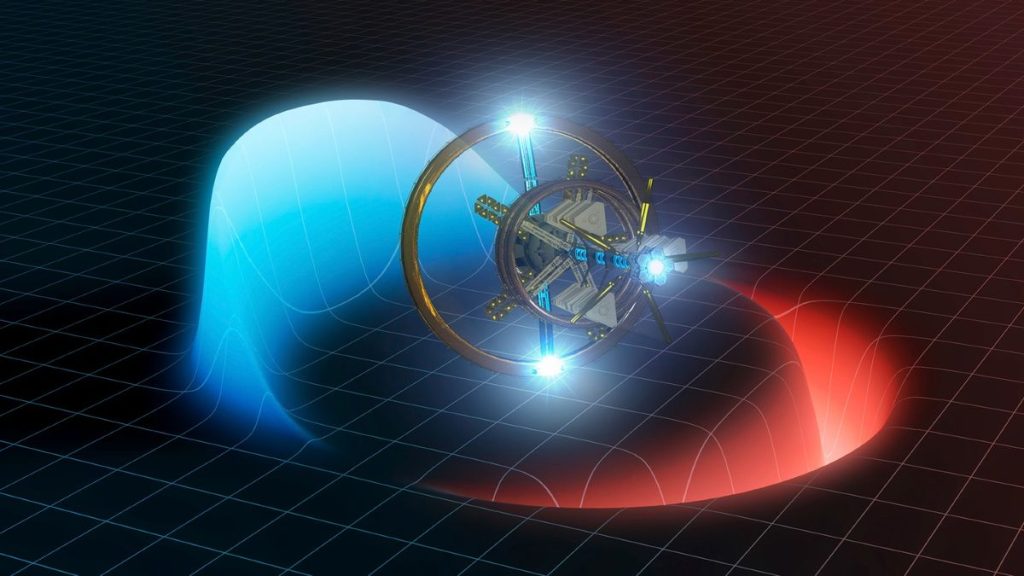
In 1994, Mexican theoretical physicist Miguel Alcubierre decided to figure out if the “warp drive” from his favorite science fiction shows was possible. Amazingly, he found a way to make it feasible, but it’s still unclear if it could ever actually work.
Although it’s impossible to travel faster than light, the restriction applies only to local measurements. It’s possible to manipulate space-time in such a way that superluminal motion is achievable. For example, the expansion of the universe drives apart galaxies faster than the speed of light, but because every galaxy is at rest in its local patch of space, it’s all good.
Alcubierre’s idea was to employ a similar trick. His warp drive solution to general relativity employs a region of perfectly flat space. In front of that bubble is a region of compressed space, and behind it is a region of expanded space. This crunching up of space allows the interior bubble and its contents to move at any speed it wants — even faster than light. Amazingly, the occupants of the bubble won’t feel anything weird. In fact, from their perspective, they won’t be moving at all. Instead, their destination simply comes closer. But there’s one problem: To construct a space-time with this precise geometry, we must employ negative mass, which doesn’t appear to exist in the universe and would violate everything we know about motion, momentum and energy.
Even though there isn’t any negative mass that we know of in the universe, there is negative energy. If you take two metal plates and hold them very close together, the quantum fields inside them are restricted; they can have only certain allowed wavelengths. This restriction, known as the Casimir effect, results in an attractive force between the plates and a region of negative energy.
A minuscule amount of Casimir-effect negative energy isn’t enough to power a warp drive, though — and it may not work out anyway. Whether an Alcubierre warp drive is allowed is ultimately a question for quantum gravity, which we do not yet have a solution for.
In the meantime, we can only skirt around the edges, poking at various aspects of the warp drive and seeing what might happen to the quantum fields in that highly strange gravitational environment. This process of poking around has led to some interesting — and sometimes contradictory — insights about the nature of warp drives in the three decades since Alcubierre’s original discovery.
For example, one set of calculations suggests that quantum fields at the edge of the warp bubble that sort of straddle the boundary between the inside bits and the outside essentially blow up to infinity as soon as you turn the thing on, which would be … bad.
Breaking space news, the latest updates on rocket launches, skywatching events and more!
But other calculations say that applies only in limited cases and that if you ramp up the warp engine slowly enough, you’ll be fine.
Yet more calculations sidestep all of this and just look at how much negative energy you actually need to construct your warp drive. And the answer is, for a single macroscopic bubble — say, 30 feet (100 meters) across — you would need 10 times more negative energy than all of the positive energy contained in the entire universe, which isn’t very promising.
However, still other calculations show that this immense amount applies only to the traditional warp bubble as defined by Alcubierre. It might be possible to reshape the bubble so there’s a tiny “neck” in the front that’s doing the work of compressing space and then it balloons out to an envelope to contain the warp bubble. This minimizes any quantum weirdness so that you need only about a star’s worth of negative energy to shape the drive.
But even more calculations show that even if you get ahold of some negative energy or negative mass, as soon as you start moving, you’re going to run into problems — namely, that the negative mass will immediately start flowing out of the edge of the bubble (which is bad) at a speed faster than light (which is really bad). What ends up happening is that the exotic matter constructing the warp bubble can’t keep pace with the bubble itself, so it just tears itself apart.
So, although warp drive seems implausible, the final verdict is uncertain. But it’s still a fun thought experiment that allows us to explore some interesting and surprising connections between general relativity and quantum mechanics. And, of course, it makes our sci-fi shows more fun to watch — we don’t have to wait millions of years for our favorite spaceship crew to reach their destination.







